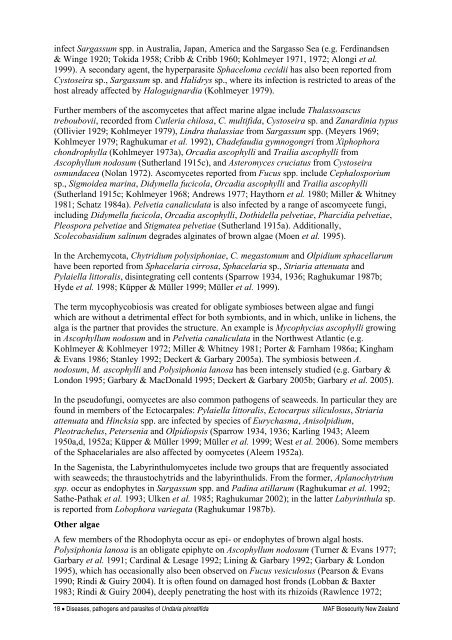Diseases, pathogens and parasites of Undaria pinnatifida
Diseases, pathogens and parasites of Undaria pinnatifida
Diseases, pathogens and parasites of Undaria pinnatifida
Create successful ePaper yourself
Turn your PDF publications into a flip-book with our unique Google optimized e-Paper software.
infect Sargassum spp. in Australia, Japan, America <strong>and</strong> the Sargasso Sea (e.g. Ferdin<strong>and</strong>sen<br />
& Winge 1920; Tokida 1958; Cribb & Cribb 1960; Kohlmeyer 1971, 1972; Alongi et al.<br />
1999). A secondary agent, the hyperparasite Sphaceloma cecidii has also been reported from<br />
Cystoseira sp., Sargassum sp. <strong>and</strong> Halidrys sp., where its infection is restricted to areas <strong>of</strong> the<br />
host already affected by Haloguignardia (Kohlmeyer 1979).<br />
Further members <strong>of</strong> the ascomycetes that affect marine algae include Thalassoascus<br />
treboubovii, recorded from Cutleria chilosa, C. multifida, Cystoseira sp. <strong>and</strong> Zanardinia typus<br />
(Ollivier 1929; Kohlmeyer 1979), Lindra thalassiae from Sargassum spp. (Meyers 1969;<br />
Kohlmeyer 1979; Raghukumar et al. 1992), Chadefaudia gymnogongri from Xiphophora<br />
chondrophylla (Kohlmeyer 1973a), Orcadia ascophylli <strong>and</strong> Trailia ascophylli from<br />
Ascophyllum nodosum (Sutherl<strong>and</strong> 1915c), <strong>and</strong> Asteromyces cruciatus from Cystoseira<br />
osmundacea (Nolan 1972). Ascomycetes reported from Fucus spp. include Cephalosporium<br />
sp., Sigmoidea marina, Didymella fucicola, Orcadia ascophylli <strong>and</strong> Trailia ascophylli<br />
(Sutherl<strong>and</strong> 1915c; Kohlmeyer 1968; Andrews 1977; Haythorn et al. 1980; Miller & Whitney<br />
1981; Schatz 1984a). Pelvetia canaliculata is also infected by a range <strong>of</strong> ascomycete fungi,<br />
including Didymella fucicola, Orcadia ascophylli, Dothidella pelvetiae, Pharcidia pelvetiae,<br />
Pleospora pelvetiae <strong>and</strong> Stigmatea pelvetiae (Sutherl<strong>and</strong> 1915a). Additionally,<br />
Scolecobasidium salinum degrades alginates <strong>of</strong> brown algae (Moen et al. 1995).<br />
In the Archemycota, Chytridium polysiphoniae, C. megastomum <strong>and</strong> Olpidium sphacellarum<br />
have been reported from Sphacelaria cirrosa, Sphacelaria sp., Striaria attenuata <strong>and</strong><br />
Pylaiella littoralis, disintegrating cell contents (Sparrow 1934, 1936; Raghukumar 1987b;<br />
Hyde et al. 1998; Küpper & Müller 1999; Müller et al. 1999).<br />
The term mycophycobiosis was created for obligate symbioses between algae <strong>and</strong> fungi<br />
which are without a detrimental effect for both symbionts, <strong>and</strong> in which, unlike in lichens, the<br />
alga is the partner that provides the structure. An example is Mycophycias ascophylli growing<br />
in Ascophyllum nodosum <strong>and</strong> in Pelvetia canaliculata in the Northwest Atlantic (e.g.<br />
Kohlmeyer & Kohlmeyer 1972; Miller & Whitney 1981; Porter & Farnham 1986a; Kingham<br />
& Evans 1986; Stanley 1992; Deckert & Garbary 2005a). The symbiosis between A.<br />
nodosum, M. ascophylli <strong>and</strong> Polysiphonia lanosa has been intensely studied (e.g. Garbary &<br />
London 1995; Garbary & MacDonald 1995; Deckert & Garbary 2005b; Garbary et al. 2005).<br />
In the pseud<strong>of</strong>ungi, oomycetes are also common <strong>pathogens</strong> <strong>of</strong> seaweeds. In particular they are<br />
found in members <strong>of</strong> the Ectocarpales: Pylaiella littoralis, Ectocarpus siliculosus, Striaria<br />
attenuata <strong>and</strong> Hincksia spp. are infected by species <strong>of</strong> Eurychasma, Anisolpidium,<br />
Pleotrachelus, Petersenia <strong>and</strong> Olpidiopsis (Sparrow 1934, 1936; Karling 1943; Aleem<br />
1950a,d, 1952a; Küpper & Müller 1999; Müller et al. 1999; West et al. 2006). Some members<br />
<strong>of</strong> the Sphacelariales are also affected by oomycetes (Aleem 1952a).<br />
In the Sagenista, the Labyrinthulomycetes include two groups that are frequently associated<br />
with seaweeds; the thraustochytrids <strong>and</strong> the labyrinthulids. From the former, Aplanochytrium<br />
spp. occur as endophytes in Sargassum spp. <strong>and</strong> Padina atillarum (Raghukumar et al. 1992;<br />
Sathe-Pathak et al. 1993; Ulken et al. 1985; Raghukumar 2002); in the latter Labyrinthula sp.<br />
is reported from Lobophora variegata (Raghukumar 1987b).<br />
Other algae<br />
A few members <strong>of</strong> the Rhodophyta occur as epi- or endophytes <strong>of</strong> brown algal hosts.<br />
Polysiphonia lanosa is an obligate epiphyte on Ascophyllum nodosum (Turner & Evans 1977;<br />
Garbary et al. 1991; Cardinal & Lesage 1992; Lining & Garbary 1992; Garbary & London<br />
1995), which has occasionally also been observed on Fucus vesiculosus (Pearson & Evans<br />
1990; Rindi & Guiry 2004). It is <strong>of</strong>ten found on damaged host fronds (Lobban & Baxter<br />
1983; Rindi & Guiry 2004), deeply penetrating the host with its rhizoids (Rawlence 1972;<br />
18 • <strong>Diseases</strong>, <strong>pathogens</strong> <strong>and</strong> <strong>parasites</strong> <strong>of</strong> <strong>Undaria</strong> <strong>pinnatifida</strong> MAF Biosecurity New Zeal<strong>and</strong>

















